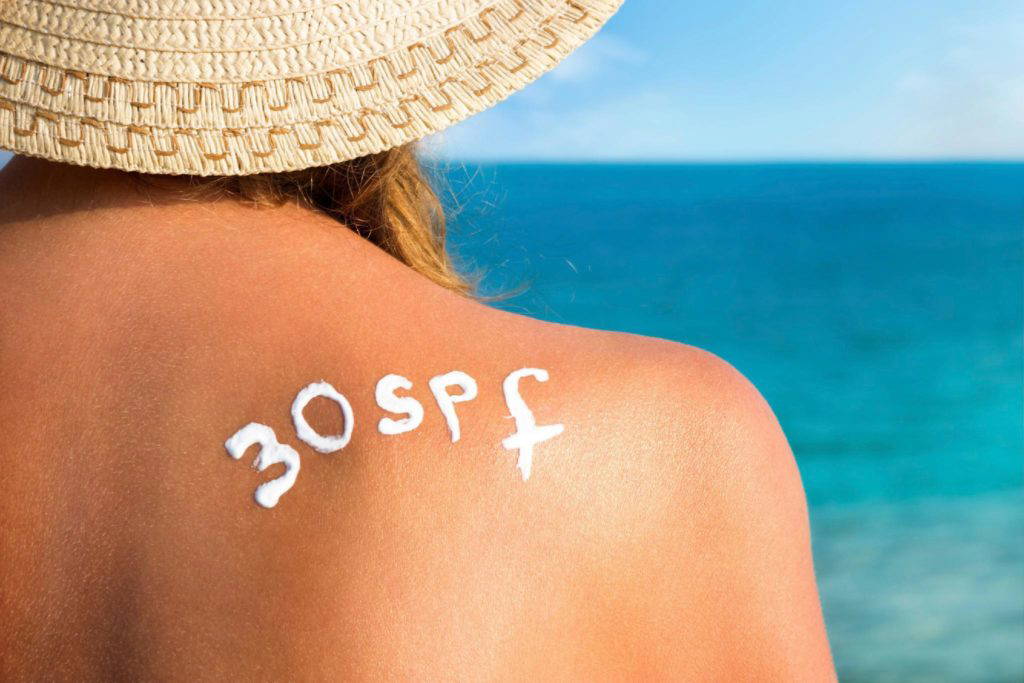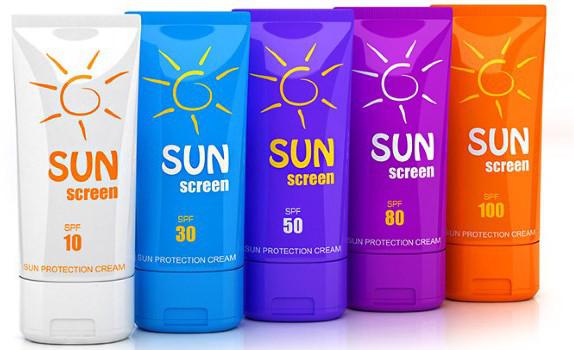
Being sun aware is a year-round job as the sun’s UV rays are present and have an effect in all four seasons. This means that even on overcast days in the Irish climate skin is being affected by UV rays. Some sun exposure is important for vitamin D levels. However, it is also true that sun exposure is the main cause of skin cancer so we need to be mindful of that throughout the year.
While most of us are aware that we should protect skin during high summer, or while on holidays, it can seem strange to care for skin in colder months. However, even in spring and autumn, the sun’s UV levels can be high enough to cause damage that can lead to skin cancers like melanoma, basal cell carcinoma and squamous cell carcinoma. With this in mind, the Irish Cancer Society advises protecting skin every day from April to September whatever the weather.
Note: in warmer months, sunscreen is not enough to provide skin with full protection; you should make sure to seek the shade during the hours of 11am and 3pm, when the sun is at its strongest, and wear adequate clothes and sunglasses too.
Some sort of sun protection product should be part of your daily regime to reduce the risk of developing skin cancer. They come in a variety of formulations; creams, gels, sprays and lotions. However, there are a number of elements to consider regardless of which one you use.
This relates to the level of protection from UV rays offered. Experts generally agree that for incidental sun exposure, such as when you’re outside for only a few minutes at a time – going from the car to the office, walking to the shop etc, a sun protection factor of 15 is adequate. The general recommendation, however, is SPF 30.
Using a moisturiser with built-in SPF can be adequate for incidental sun exposure but it is advisable to use a separate suncare product. There are many on the market now and the formulations mean they can be easily layered over foundation and under makeup without clogging skin.
It is worth keeping in in mind that SPF 30 does not provide twice the protection of SPF 15. SPF 15 absorbs 93% of UVB rays, while SPF 30 absorbs 97% and an SPF of 50 absorbs 98% of UVB.
To ensure protection from UVA you need a product with ‘broad spectrum’ protection. Some brands have adopted a star system to indicate the level of UVA protection in the product, so make sure your product of choice has this all-round level of care.
No sunscreen is 100% waterproof or sweatproof, but they can be resistant to water and sweat up to a certain amount of time. Your sunscreen bottle should indicate whether it remains effective for 40 minutes or 80 minutes, so if you are swimming, or likely to sweat a lot, it is important to know how long you will be protected for, and reapply the sunscreen regularly.

Your sunscreen bottle should also detail the ingredients, both physical and chemical, that make up the cream or lotion. Chemical ingredients such as avobenzone and benzophenone work by absorbing UV rays, thus reducing the level that penetrates the skin. Physical ingredients such as titanium dioxide and zinc oxide sit on top of the skin and deflect UV rays away from it. Many sunscreen products combine both types of ingredient, so you should look for those most effective in protecting your skin.
Proper application is very important and sometimes overlooked. For adequate protection you need to apply sufficient product and in the correct manner. Too many people just slap on some sunscreen and use it sparingly but this will not give the protection they think they’re getting.
Apply SPF to dry skin about 20 minutes before sun exposure.
For an adult, typically you should use 35mls of product to cover the whole body.
Use a tablespoon worth of sun cream to cover your face and neck.
SPF should be reapplied frequently - every two hours is usually the suggested time frame. Of course if you are in hot sun and sweating or exercising, you should apply SPF more frequently.
Be careful of ‘use by’ dates – they should be indicated on the packaging. This is sometime a date stamp, or it may be a number of months or years before first use. Don’t hold onto sun protection products for next summer.
Good sun care doesn’t have to be expensive. Many pharmacies and even supermarket brands have very advanced and well-tested sun products. Just make sure to look for a high factor, broad-spectrum option.
If you are concerned about your moles or lesions on your skin or that of a loved one, arrange a consultation with me at my clinic, and download our guide to sun protection:
Download Mr Chan's Guide to Proper Sunscreen Use

Being sun aware is a year-round job as the sun’s UV rays are present and have an effect in all four seasons. This means that even on overcast days in the Irish climate skin is being affected by UV rays. Some sun exposure is important for vitamin D levels. However, it is also true that sun exposure is the main cause of skin cancer so we need to be mindful of that throughout the year.
While most of us are aware that we should protect skin during high summer, or while on holidays, it can seem strange to care for skin in colder months. However, even in spring and autumn, the sun’s UV levels can be high enough to cause damage that can lead to skin cancers like melanoma, basal cell carcinoma and squamous cell carcinoma. With this in mind, the Irish Cancer Society advises protecting skin every day from April to September whatever the weather.
Note: in warmer months, sunscreen is not enough to provide skin with full protection; you should make sure to seek the shade during the hours of 11am and 3pm, when the sun is at its strongest, and wear adequate clothes and sunglasses too.
Some sort of sun protection product should be part of your daily regime to reduce the risk of developing skin cancer. They come in a variety of formulations; creams, gels, sprays and lotions. However, there are a number of elements to consider regardless of which one you use.
This relates to the level of protection from UV rays offered. Experts generally agree that for incidental sun exposure, such as when you’re outside for only a few minutes at a time – going from the car to the office, walking to the shop etc, a sun protection factor of 15 is adequate. The general recommendation, however, is SPF 30.
Using a moisturiser with built-in SPF can be adequate for incidental sun exposure but it is advisable to use a separate suncare product. There are many on the market now and the formulations mean they can be easily layered over foundation and under makeup without clogging skin.
It is worth keeping in in mind that SPF 30 does not provide twice the protection of SPF 15. SPF 15 absorbs 93% of UVB rays, while SPF 30 absorbs 97% and an SPF of 50 absorbs 98% of UVB.
To ensure protection from UVA you need a product with ‘broad spectrum’ protection. Some brands have adopted a star system to indicate the level of UVA protection in the product, so make sure your product of choice has this all-round level of care.
No sunscreen is 100% waterproof or sweatproof, but they can be resistant to water and sweat up to a certain amount of time. Your sunscreen bottle should indicate whether it remains effective for 40 minutes or 80 minutes, so if you are swimming, or likely to sweat a lot, it is important to know how long you will be protected for, and reapply the sunscreen regularly.

Your sunscreen bottle should also detail the ingredients, both physical and chemical, that make up the cream or lotion. Chemical ingredients such as avobenzone and benzophenone work by absorbing UV rays, thus reducing the level that penetrates the skin. Physical ingredients such as titanium dioxide and zinc oxide sit on top of the skin and deflect UV rays away from it. Many sunscreen products combine both types of ingredient, so you should look for those most effective in protecting your skin.
Proper application is very important and sometimes overlooked. For adequate protection you need to apply sufficient product and in the correct manner. Too many people just slap on some sunscreen and use it sparingly but this will not give the protection they think they’re getting.
Apply SPF to dry skin about 20 minutes before sun exposure.
For an adult, typically you should use 35mls of product to cover the whole body.
Use a tablespoon worth of sun cream to cover your face and neck.
SPF should be reapplied frequently - every two hours is usually the suggested time frame. Of course if you are in hot sun and sweating or exercising, you should apply SPF more frequently.
Be careful of ‘use by’ dates – they should be indicated on the packaging. This is sometime a date stamp, or it may be a number of months or years before first use. Don’t hold onto sun protection products for next summer.
Good sun care doesn’t have to be expensive. Many pharmacies and even supermarket brands have very advanced and well-tested sun products. Just make sure to look for a high factor, broad-spectrum option.
If you are concerned about your moles or lesions on your skin or that of a loved one, arrange a consultation with me at my clinic, and download our guide to sun protection:
Download Mr Chan's Guide to Proper Sunscreen Use